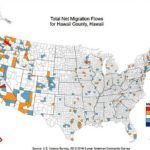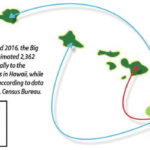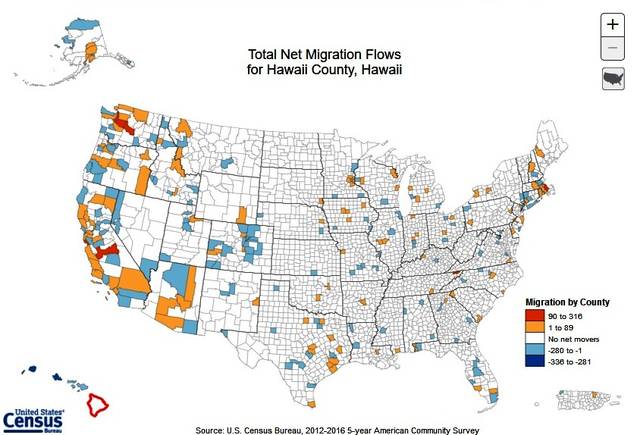The Big Island: Coming and going


HILO — Hawaii Island is gaining people, but they’re not coming from the rest of the state.
In fact, between 2012 and 2016, the Big Island lost an estimated 2,362 people annually to the other three counties in Hawaii, while adding just 1,654, according to data released Tuesday by the U.S. Census Bureau.
The loss is more than made up by resident births and by migration from the U.S. mainland and other countries, said Eugene Tian, administrator of the state’s Research and Economic Analysis Division. The Hawaii Island population grew from 198,681 in July 2016 to 200,381 in July 2017, and was leading the state in the rate of population growth, according to earlier census estimates.
Tian can’t pin down why Hawaii residents leave the Big Island for the other islands, especially for data accumulated before this year’s volcanic eruption. The island has the lowest housing costs and a lower cost of living than the other islands.
But even before the May 3 Kilauea eruption that took out more than 700 homes in Puna, lava flows were a major concern for at least one outward migrator. Toni Robert, a 25-year resident, said the smaller, June 2014, lava flow was the deciding factor for her family. She moved to the mainland in late 2014, ultimately settling in Mansfield, Ohio.
“To be honest, it was the hardest decision I’d ever made,” Robert said in a Facebook response. “My husband was ready when our daughter suggested in September but I loved living there and it took my health being compromised by environmental impact and the thought of living literally a block from the projected flow field as it was projected to flow through (Hawaiian) Beaches towards the ocean. Thank goodness it never happened, but in retrospect having watched from afar as lava devastated lower Puna this year it seems it was the right thing for us to have done.”
Some, such as Hawi resident Nancy Adkins, came to the Big Island to retire. She moved from Delaware in 2015.
“Would not change anything except wish we had come so much sooner if we could have managed it,” Adkins said. “Should have started here.”
Kona resident Julie Chancerelle Ziemelis literally wrote the book: “How to Move to Kona.” A former communications director in Santa Clara, California, she and her family moved to the area in 2005, but then moved back to California until 2010, when they moved to Kona full time. Ziemelis is a blogger and has a Facebook group for Kona newbies.
Jobs are a big factor for some people, while others leave to be closer to family, according to a Facebook discussion conducted over the past three days.
Steve Pavao, who hails from Hilo, moved to Oahu for work in 2013, taking a position with the state Department of Health. He transferred to the Big Island in 2016, first to Kailua-Kona, and then to Hilo.
“Always love the Big Island. It’s home,” Pavao said.
Longtime Hilo resident Nanci Munroe spent 16 years on Oahu, working for Hawaiian Telcom. She moved back to Hilo upon her retirement in 2012, but in 2014 spent six months on Oahu for family reasons.
“In just the two years I’d been gone, the place had gone nuts!! Rent just through the roof!! Traffic volume increased so much!” Munroe said, adding that she did enjoy “all the events and city action,” and meeting up with old friends.
Top mainland sources of new Big Island residents are the Seattle area with an average 608 new Hawaii Islanders annually, Santa Cruz-Fresno, California area with 347 and Sullivan County, Tennessee, with 216, according to census estimates.
Most Big Island residents who leave move to Oahu or Kauai rather than to the mainland. The estimates are based on five years’ survey data, and are subject to sampling errors when dealing with smaller numbers.
About 87 percent of the 1.4 million Hawaii population age 1 year and older lived in the same house in 2017 they’d lived in the prior year, according to another recently released census survey. Of the rest, 115,683 lived elsewhere in the state a year prior, 46,457 lived in some other U.S. state and 17,270 lived abroad, according to the report.
That’s a reduction of in-migration to Hawaii from 2016, when 57,229 had lived in some other U.S. state and 17,431 had lived abroad.




If locals are leaving one might suspect it could our mayor and local infrastructure, just a guess… Newbies will figure it out eventually>>>>
Hah, newbies are just counting on the fact that they don’t have to pay any income tax on their pensions! But at least here they will be the only ones to “get what they pay for” which is zero for us people who live here and work.
But all those “Fat Cats” working government jobs here in HI do not have to pay income tax either. Why do you think they set it up that way. Keep all the jobs for their families and friends and when they retire pay nothing on the backs of us!
My back is getting tired>>
How do they estimate this if there has been no census and there is no civil register in the town (Napoleon was never here)?
Why do so many people come here from those ‘red’ counties?
The real problem for both an aging demographic of people who reside on the Big Island and also retirees who relocate here is health care and infastructure. If Harry Kim had half a brain he would do a better job with infrastructure and also insure the healthcare system isn’t burdened with redundant regulations that prevent people from practicing here. The reason people are leaving the Big Island for Oahu is predominantly healthcare based. One trip to Kona Community Hospital here and between the traveling physicians from Locums and the standards of care there, it’s no wonder Queen’s in Oahu wouldn’t touch that place, it’s like a trip to a third world medical facility.
Mainland (move-in) arrivals to the Big Island soon discover island life has its challenges and rewards.
Leaving the life, we’ll leave to the tourism brochures. Real island life means living with a chronic shortage of doctors and essential medical services. The only real full service medical system on Hawai’i Island is Kaiser, and even the big K is feeling the pain of a chronic shortage of qualified medical practitioners, the legacy of a strategy for lowering operating costs by flying their members in need to Oahu for many medical services and labs when the big Island had a smaller population. The discovery of the absence of medical choices leaves newcomers to the island dumbfounded when what they took for granted – medical options that were easily and conveniently available on the mainland, are a day trip or longer away and come at a higher cost.
Then there is living at the end of the island supply-chain, which too often requires being your own personal Costco in order to ensure that you want is available when you need it.
Last, but not least, Hawaii’s famous cost living and a vampire tax (excise tax) which taxes everything at every stage of every transaction as often as possible, and is poorly matched to a local county government budget that is out of balance with the services it provides to its residents and businesses. One thing is certain, key westside roads (e.g. Hini Lani) and other key connectors (other than the recently completed and Federally funded Queen K expansion), have been left to return to gravel instead of being maintained, absent any attention by Hilo-centric Dept. of Public Works.
According to the same Census numbers the state of Hawaii was one of just a few states which lost population in 2017. The beauty, the weather, and the culture are hard to beat but high costs, high taxes lacking healthcare, and no economic opportunity seems to motivate more and more people to move. It is a tragedy that the things we have control over are driving people away!